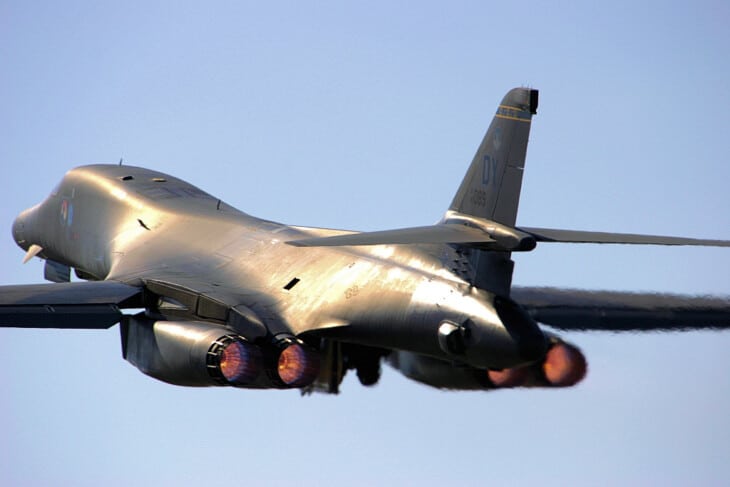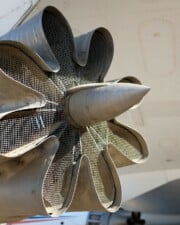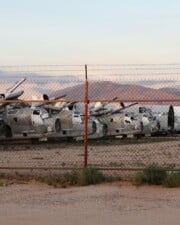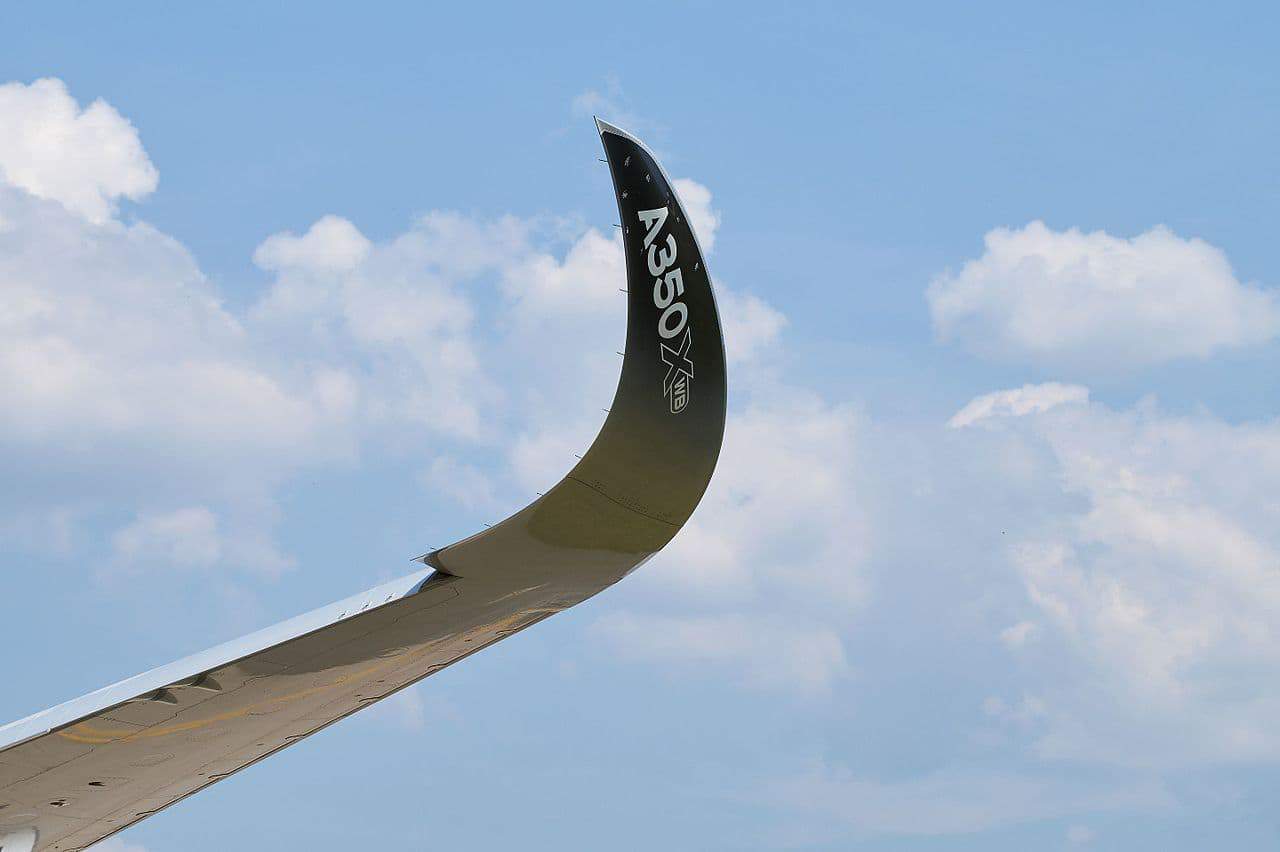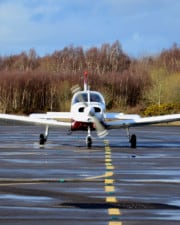If you’ve ever seen a fighter jet from behind during takeoff, you’ve probably noticed that the engines have a certain glow. This glow is caused by something called an afterburner, but what exactly is it?
An afterburner, also called a reheat in some countries, is an additional component added to some jet engines to increase thrust. The main use of an afterburner is to help these aircraft, typically military fighter jets, achieve supersonic flight.
What is an Afterburner?
Afterburners are additional components added to the end of a jet engine. They work by injecting fuel directly into the engine’s exhaust before a spark ignites the fuel (which is now mixed with the remaining oxygen in the exhaust).
This spark creates a stream of fire (not too dissimilar to what comes out of the end of a blowtorch) which is then confined and expelled through a tight nozzle.
Due to having a large amount of power pushed out of a comparatively small hole, the thrust of the aircraft is increased, thus increasing both its speed and range. Indeed, the activation of an afterburner can increase thrust by as much as 50%, whilst range increases by 30-40%.
How is an Afterburner Activated?
The process a pilot follows to activate the afterburners is a rather simple one. There are no buttons, toggles or levers that need to be pressed, pulled or removed; it’s simply a matter of pushing the thrust lever.
To activate the afterburner on nearly all aircraft, all pilots need to do is push the thrust lever to full thrust, activating the afterburner automatically.
On many jets, the afterburner actually activates before the lever reaches full thrust. The point at which the afterburner is activated is usually noted on the lever itself, just as other stages of the engine (eg. idle) are.
Can a Fighter Jet Take Off Without an Afterburner?
Despite almost every single afterburner-equipped fighter jet using their afterburner to aid taking off, a fighter jet can absolutely take off without using their afterburner.

The main reason why fighter jets tend to take off with the use of afterburners is safety. Whilst the runways are more than long enough to accommodate the jets, the longer amount of time they spend on the runway, the more (and easier) of a target they are.
Therefore, most military pilots flying jets equipped with afterburners are taught to always takeoff with the afterburner, except in the case of naval pilots on aircraft carriers, who are taught to add it just as they’re taking off.
Why Do Pilots Use Afterburners?
When they’re not using the afterburner to take off, there are a few different reasons a pilot might have for using the afterburner to go supersonic in flight.
The most common reason a pilot might use their afterburner is to evade the enemy. Whilst most fighter jets are rarely shot at by foreign powers these days, it’s still (relatively) common to come across unfriendly foreign aircraft.
If a pilot has picked up a foreign aircraft flying under the flag of a country not friendly to their own, they may choose to get out of there quickly rather than risk a potential incident. The way they do this is by activating the afterburner and going supersonic in another direction.
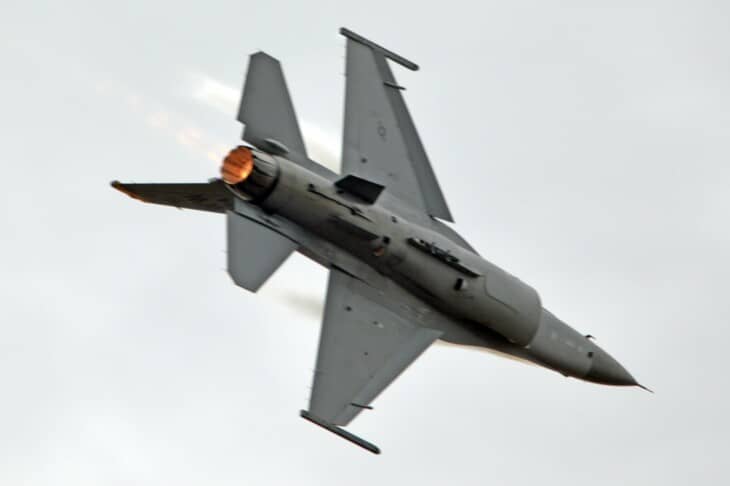
The other main reason why a pilot might go supersonic is to intercept a foreign aircraft which is straying into airspace controlled by the pilot’s country without permission.
A pilot might activate full afterburner during takeoff to ensure they get to the foreign aircraft’s location before any incidents can arise, before escorting them out of their airspace.
Other reasons for pilots activating the afterburner are mainly to do with airshow flying (for example stunts like the famed “pump-and-burn”) as well as for photographic purposes either by military or civilian photographers.
Can Fighter Jets go Supersonic Without an Afterburner?
Although afterburners are most commonly used to help jets go supersonic, some aircraft can go supersonic without an afterburner. Most of the aircraft capable of this are brand new fifth generation fighters like the F-22.

The reason they’re able to go supersonic without the use of an afterburner is due to careful weight balancing and thrust ratios.
Put simply, aircraft engineers at companies like Lockheed have designed new fighters to be so light that the engines that power them are so powerful, they propel the aircraft faster than the speed of sound without activating their afterburner (though many are still equipped with one).
Some of this technology has made its way into the commercial aviation sector too, in the form of supersonic transports (SSTs) like the Boom Overture that are currently under development worldwide.

Much like their military counterparts, their ability to fly at supersonic speeds without the use of afterburners has been achieved through careful weight reductions and the use of multiple high-thrust engines.
How Loud is an Afterburner?
There’s no denying that a jet engine is loud. A jet engine equipped with an afterburner, however, makes the jet engine alone seem like a library.
Afterburners create a roar somewhere in the region of 140 decibels. To put that in perspective, anywhere from 150 to 180 decibels is enough to cause lasting hearing damage!
The reason they are so loud is because of the huge wind shear they create. Air is being sucked through the engine, set alight and pushed out of the end of the afterburner at such a rate that its sheer volume cuts the surrounding air so much it’s almost deafening.
How Fast do Afterburners Burn Fuel?
Perhaps the chief hallmark (and thus criticism) of afterburners is that they are incredibly fuel inefficient.
Most afterburners equipped on modern fighter jets consume fuel at an astonishing rate – averaging at 60,000 lb per hour! This is nearly double times the 36,000 or so pounds of fuel they consume each hour when not using the afterburner.
A burn rate of 60,000 lb per hour is enough to easily use up all the fuel onboard in a matter of minutes, hence why their use is restricted to only a few minutes per flight.
How Hot Does an Afterburner Get?
Burning all that fuel, it perhaps comes as no surprise to hear that afterburners get hot. Really hot. If you’ve ever stood behind a fighter jet as it’s taking off, you’ve probably felt the immense heat of its afterburners.
All in all, afterburners can get anywhere from 1,700 to 2,040 degrees Celsius (approximately 3,100 to 3,700 degrees Fahrenheit) depending on where in the afterburner you’re taking the temperature from.
The hottest part of the afterburner is the combustion chamber (where the injected fuel is mixed with air and a spark sets it alight) whilst the rear of the afterburner is the “coolest” mostly due to the addition of a considerable amount of air, whose temperature is much lower than the afterburner’s.
Despite this, the heat an afterburner produces is considerably higher than the 660.3 °C (1220 °F) melting point of aluminum – the metal used to make an aircraft’s skin – thus requiring a heat shield around the areas surrounding the engine and thermal barrier coatings on the inside of the engine chamber.
The sheer heat of the afterburner, combined with the aforementioned near-deafening sound created by them, is why all afterburner-equipped jets have a much larger “safe distance” around them than non-afterburner-equipped ones.
This also partially explains why far fewer people get sucked into afterburner jets than non-afterburner jets.
Why do Russian Jets Have Blue Afterburners?
If you’ve ever looked at the afterburners on some Russian-made jets like the Sukhoi Su-57 or Tupolev Tu-160, you might’ve noticed that their afterburners are a distinct blue color rather than the standard yellow/orange color of most other jets.

The reason these Russian-made jets have blue afterburners is due to them using what aircraft engineers call a cold afterburner, which differs slightly to standard afterburners.
A uniquely Russian design, the reason cold afterburners have a blue flame is due to the acute angle at which the fuel is injected into the afterburner, which, when combined with the fewer and bigger injectors there, ignite the fuel in such a way it appears blue.
That being said, light also plays a role.
Due to how bright the lighting is when photographs of Russian-made jets are being taken, the mildly blue flame appears an even deeper blue, furthering the “Russian jets have blue afterburners” trope so often circulated online.
Do Commercial Planes Have Afterburners?
Afterburners are pretty standard across most modern supersonic fighter jets. On commercial jets, however, it’s a little trickier.
At one point in time, airlines were constantly looking for the next fastest aircraft. This is what led some to buy airliners like the Concorde and Tu-144, which were equipped with afterburners, which allowed them to break the sound barrier and fly supersonic.
Following a string of accidents (which partly involved the afterburners on the two supersonic airliners), their subsequent grounding and a re-evaluation of the airline industry as a whole, airlines have begun to shun speed in favor of efficiency.
As a result, no passenger airliners have been built with afterburners since then, and presently there are no commercial airliners in service equipped with afterburners.
Do Any Private Jets Have Afterburners?
Although commercial jets have had afterburners in the past, when it comes to the world of business aviation, there’s never been a factory-built private jet with an afterburner.
The reason for this is primarily due to practicality: most private jets fly transcontinental flights across land where flying supersonic isn’t permitted, meaning the addition of an afterburner doesn’t make much sense.
That doesn’t, however, mean that a private jet has never been equipped with an afterburner. Quite the opposite in fact, in 1988, the US Coast Guard equipped a Dassault Falcon 20C (tail-number N200GT) business jet with afterburners for use as a testbed.
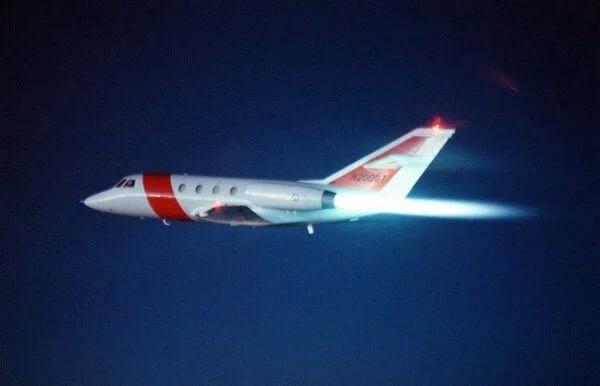
Performing a series of test flights, their aim was to see if they could develop a supersonic aircraft equipped with all the search and rescue (SAR) and tracking equipment as fighter jets weren’t fit for the job and newer turboprops were too slow for their changing role.
Despite the promise of positive results, ultimately afterburner-equipped Falcon 20s like N200GT couldn’t do the job the Coast Guard hoped it could and the project was shelved.
Subsequently, the Coast Guard retired the Falcon 20 in favor of a larger number of the considerably slower turboprops (even before N200GT was equipped with afterburners!)
N200GT marks the first and only time a private jet has been equipped and flown with afterburners.
Related Posts
